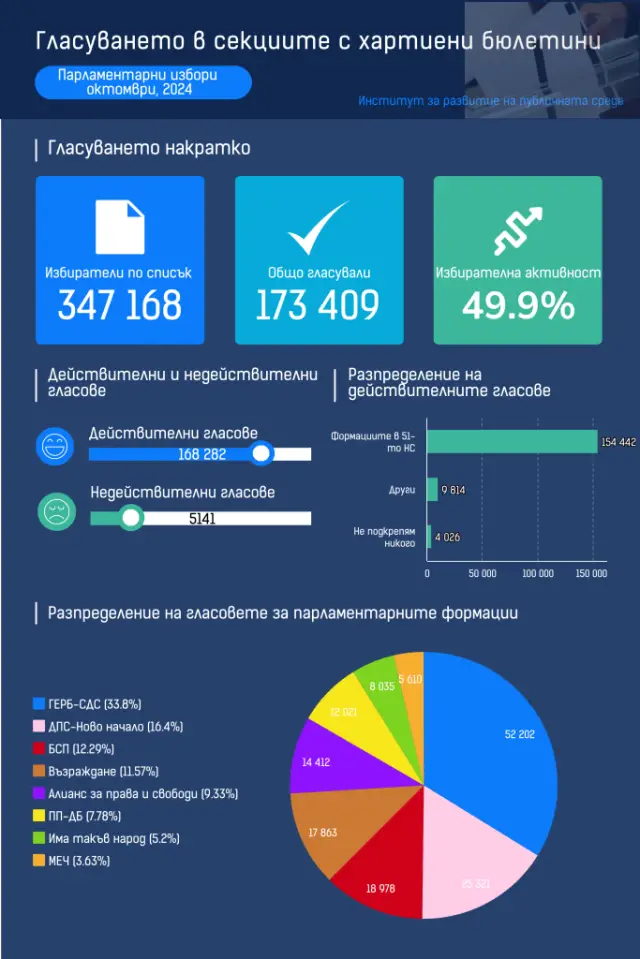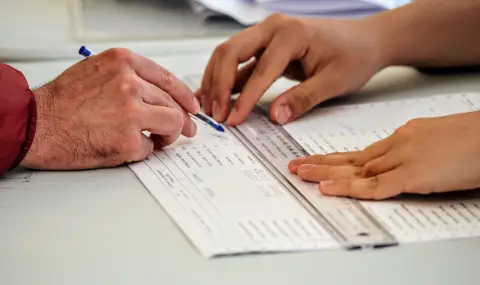On October 27, 2024, the next parliamentary elections were held in the country. Voter turnout exceeded that predicted by polling agencies and, according to the CEC's final data, reached 38.94%.
After the compilation of the voter lists, according to the instructions of the Central Election Commission, there were 9,353 sections with more than 300 voters in the territory of the country, where voters could choose how to cast their vote – whether by machine device or by paper ballot. Only one machine was provided in these sections. From the information released by the CEC, it became clear that on election day 116 machine devices in the country were taken out of use (4 of which due to lack of electrical power).
Ahead of the vote, there was again controversy over the device paper. And on Election Day, we witnessed problems with printing blank or shorter ballots. This time, the CEC sent an advance directive to the district election commissions the day before the elections. In it, the Commission instructed the members of the SEC to allow citizens to vote again with a paper ballot in similar cases with the machine voting.
Voting in machine device sections
The team of the Institute for the Development of the Public Environment analyzes the official data on the election results published by the CEC in an open format after the end of the elections.
The data show that there were a total of 6,307,568 registered voters in the mixed sections with machine and paper votes in the country, and 2,232,371 people (or 35.4%) voted in them. The actual votes cast were 2,190,328, and the invalid ones were 41,852. 41.70% of voters or 931,007 voted by machine, and by paper – 58.3% or 1,301,364 people. How the distribution of votes in these sections looks like can be seen in the graph below:

It is striking that in the three districts in the city of Sofia, voters most often cast their vote by machine. The 23rd constituency is leading with 65.51%, followed by the 24th constituency with 63.75% and the 25th constituency with 57.76%.
On the other pole in terms of using the machines are those who voted in the Kardzhali regions – 14.36%, Razgrad – 18.55% and Targovishte – 19.07%.
A detailed breakdown of the ratio of voters who voted by machine to paper, by electoral district, can be seen in the following infographic, which is interactive. In addition, from the menu next to the map, you can select one of the eight political entities represented in the 51st Parliament and find out which voting technology its supporters preferred.
The distribution of the machine vote among the parties and coalitions of the new parliament shows that, to the smallest extent, supporters of the DPS faction around Ahmed Dogan voted this way – Alliance for Rights and Freedoms. Only 12.29% of her vote in mixed voting sections was cast by machine. The other faction – DPS-New Beginning of Delyan Peevski received 13.79% of its votes by machine, followed by GERB-SDS with 33.02%.
The largest share of the machine vote is among the supporters of the coalition We Continue the Change – Democratic Bulgaria – 75.75%, followed by There is such a people –63.81% and MECH – 69.51%.
In 487 sections, not a single vote was cast on machine devices. At the opposite pole is section 234616005 in the capital's Studentski Grad quarter in the 23rd electoral district, in which 466 people cast their vote out of 596 who voted by machine.
The most impressive, however, is the second section in the town of Jebel. In it, out of 367 voters, only 1 submitted a paper ballot. There DPS-New Beginning received 94% of the votes (or 343 votes). And while the data show that the voters of this formation in the country extremely rarely preferred the machine vote, in this section all those who supported the party used a machine device.
According to the data, there are 4 more sections in the country where only 1 vote was cast by paper ballot. Two of them are in the Kardzhali region, where the majority of the votes were in support of DPS-Novo nacholo (respectively, the village of Dobrintsi and the village of Visegrad). Independent observers from the network of the Institute for the Development of the Public Environment on the ground in the Kardzhali region indicate that local sympathizers of the two factions of the DPS advised voters to vote by machine in the sections to which members from the other wing of the party were appointed.< /p>
Voting in the paper ballot sections
Voting by paper ballots took place in 2,525 polling stations across the country (not including mobile ballot boxes and the ship polling station). Their data shows that a total of 347,168 voters were included in their lists. Those who voted in the sections with ballots amounted to 173,409 people, i.e. the voter turnout was 49.95%. Of the votes cast with paper ballots, 5,141 or 2.96% were invalid.
The distribution of votes from the paper ballot sections for the eight parties and coalitions that received representation in the 51st National Assembly is interesting. These political entities collected a total of 154,442 votes (or 89.06%). The following graphic provides detailed information about the paper ballot sections.

The results show that supporters of the formations that returned the “mixed” voting with rapid changes to the Electoral Code at the end of 2022, have most taken advantage of the opportunity to vote with paper ballots.
In 36 of the sections where voting was done only by paper, the voter turnout was 100%.
The eighth section in the town of Tsarevo (Bourgas electoral district) has the most voters, where, in addition to all 182 registered voters, six people registered on election day also voted. Voters' votes are divided almost equally by DPS-New Beginning (84 votes) and GERB-SDS (77 votes). The deviations in the electoral biases of the people there have already become clear in previous elections, as the material “The controlled vote” of journalist Genka Shikerova for Free Europe.
About the voting methodology
Among the main advantages of machine voting is the absence of invalid votes. If the devices are used to their full capacity, it will also facilitate the work of the sectional commissions, especially in terms of counting the results at the end of the election day, and avoid errors and malicious actions by the members of the SEC.
The main advantage of paper voting is the physical trace that remains on the ballot and provides an opportunity to check and recount the results.
Unfortunately, in these elections we witnessed serious problems in the work of the sectional election commissions and doubts about the integrity of the vote, which led to requests from various parties to partially challenge the results or cancel the elections. But the voting technology cannot solve the problems with the overall organization of the electoral process and its fairness. In view of the political parties' requests for changes in the electoral law, this should be a topic that their leaders should be aware of.
